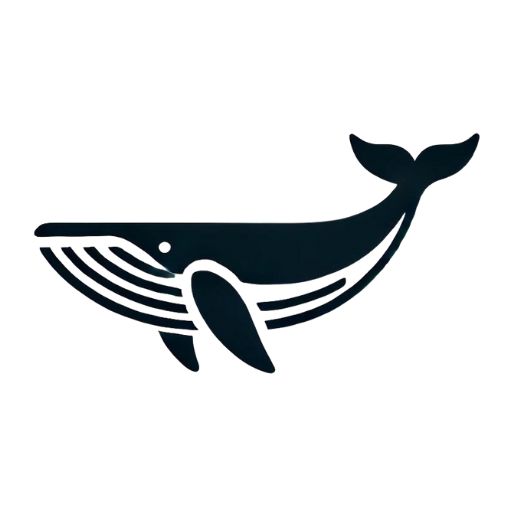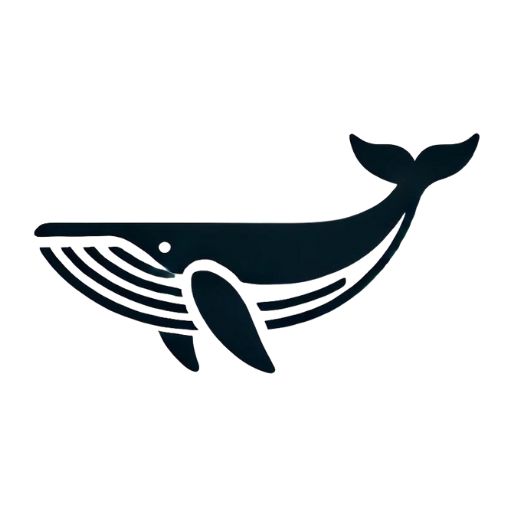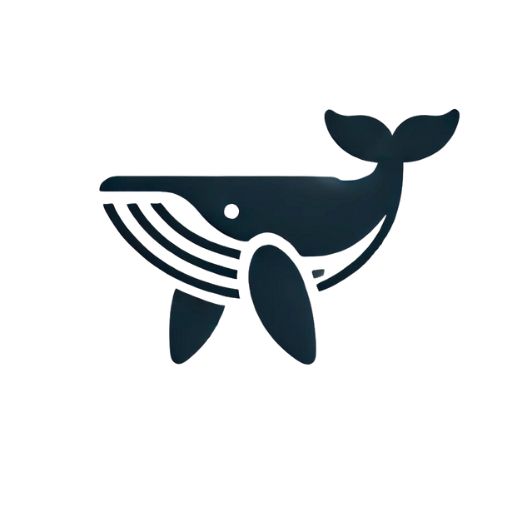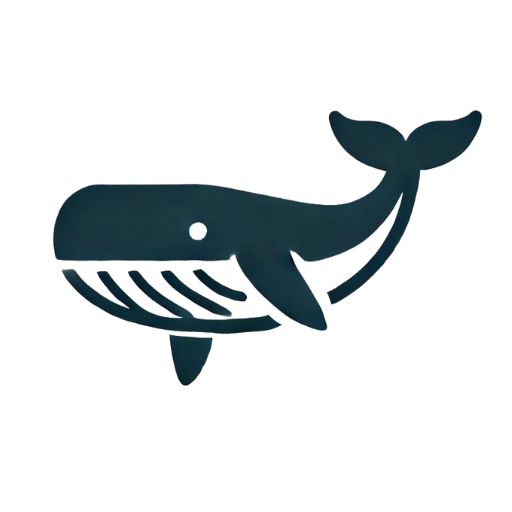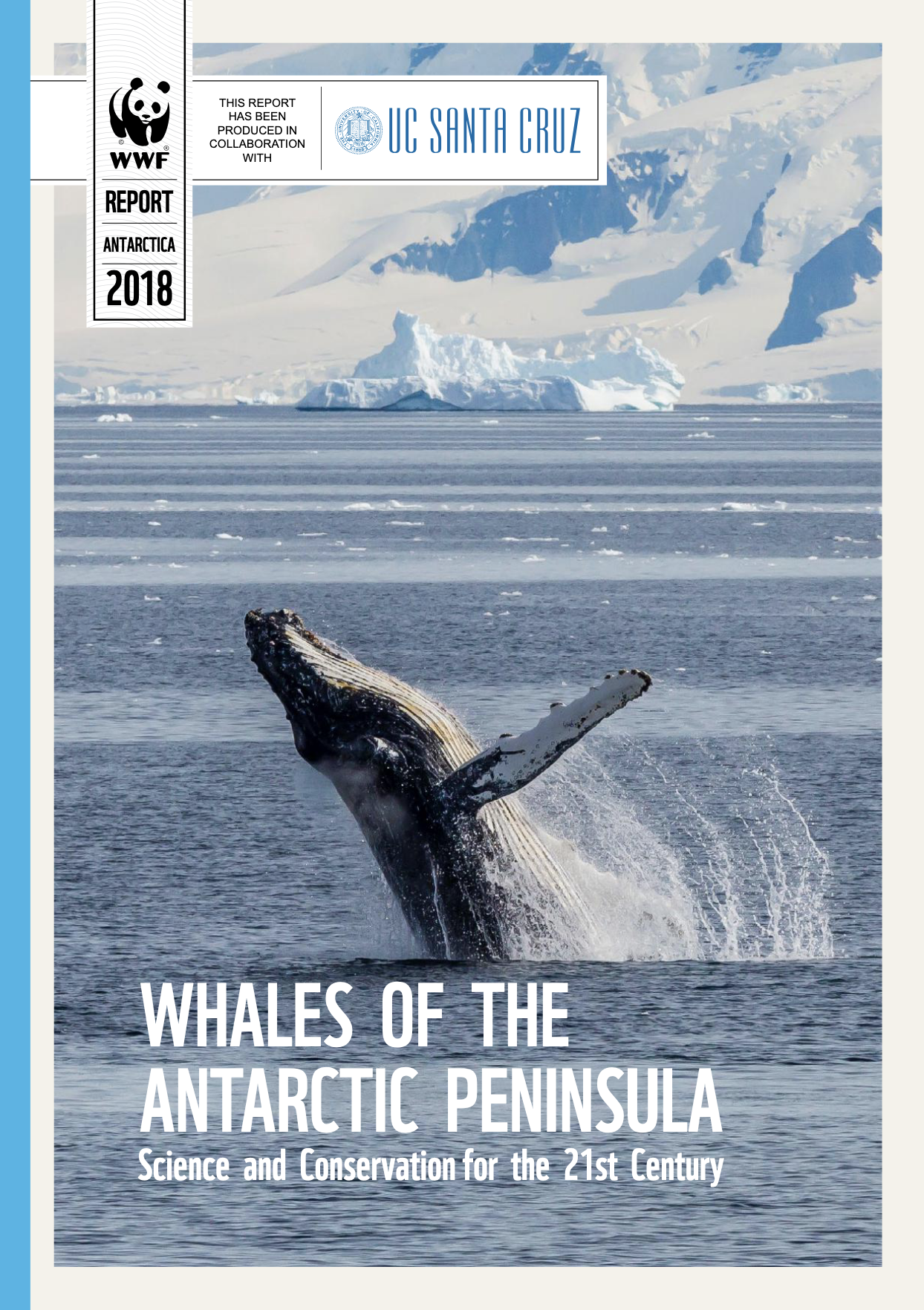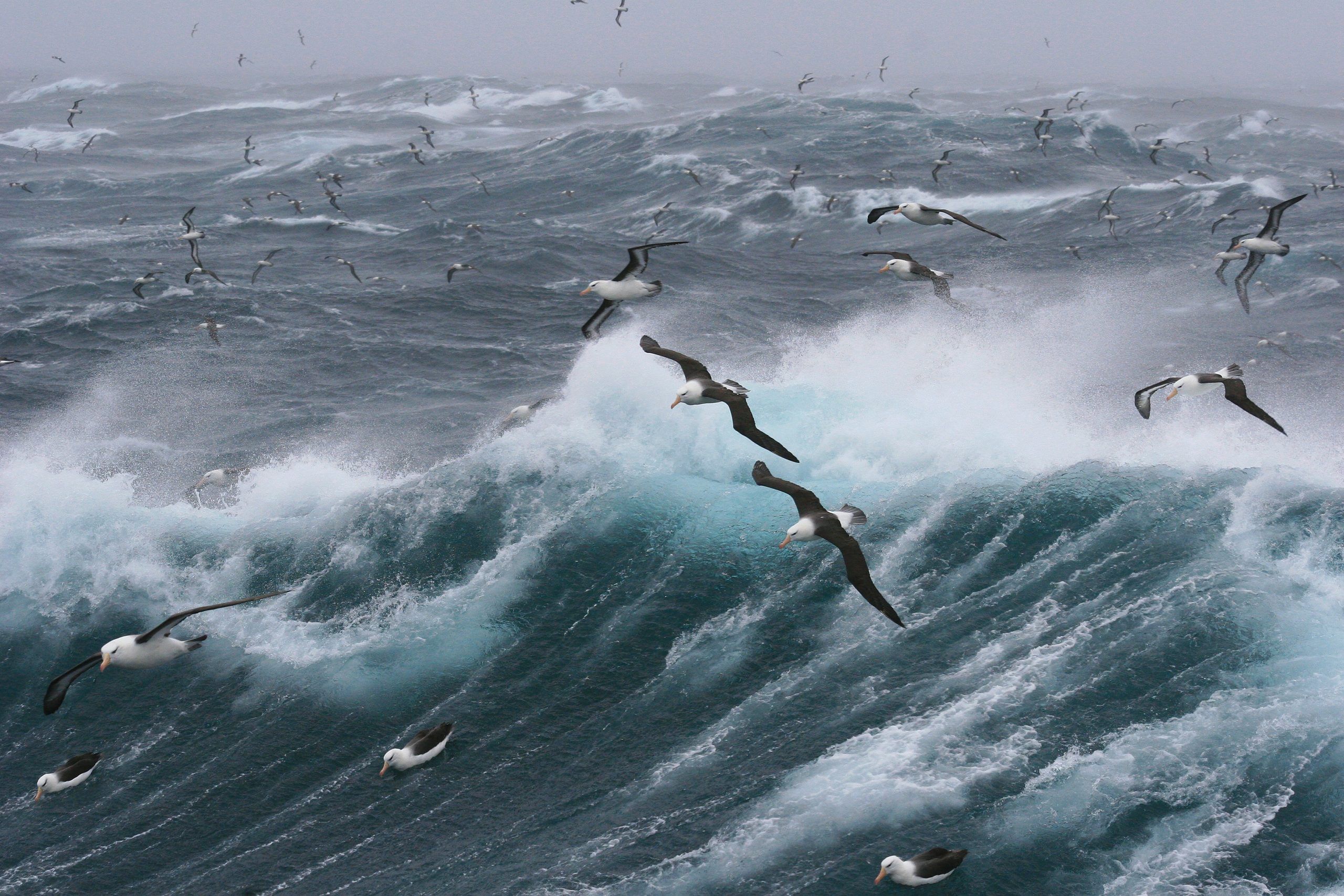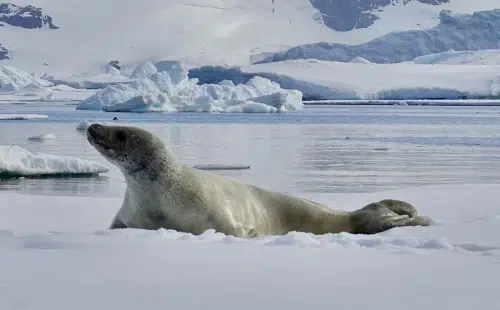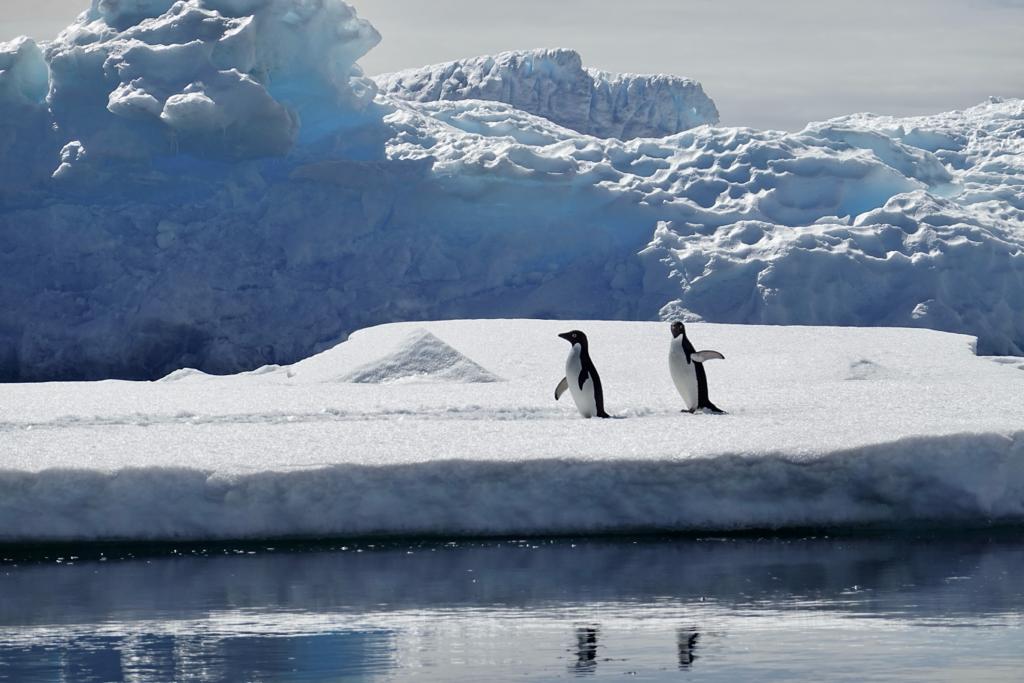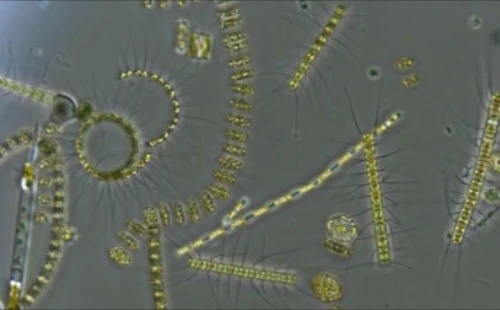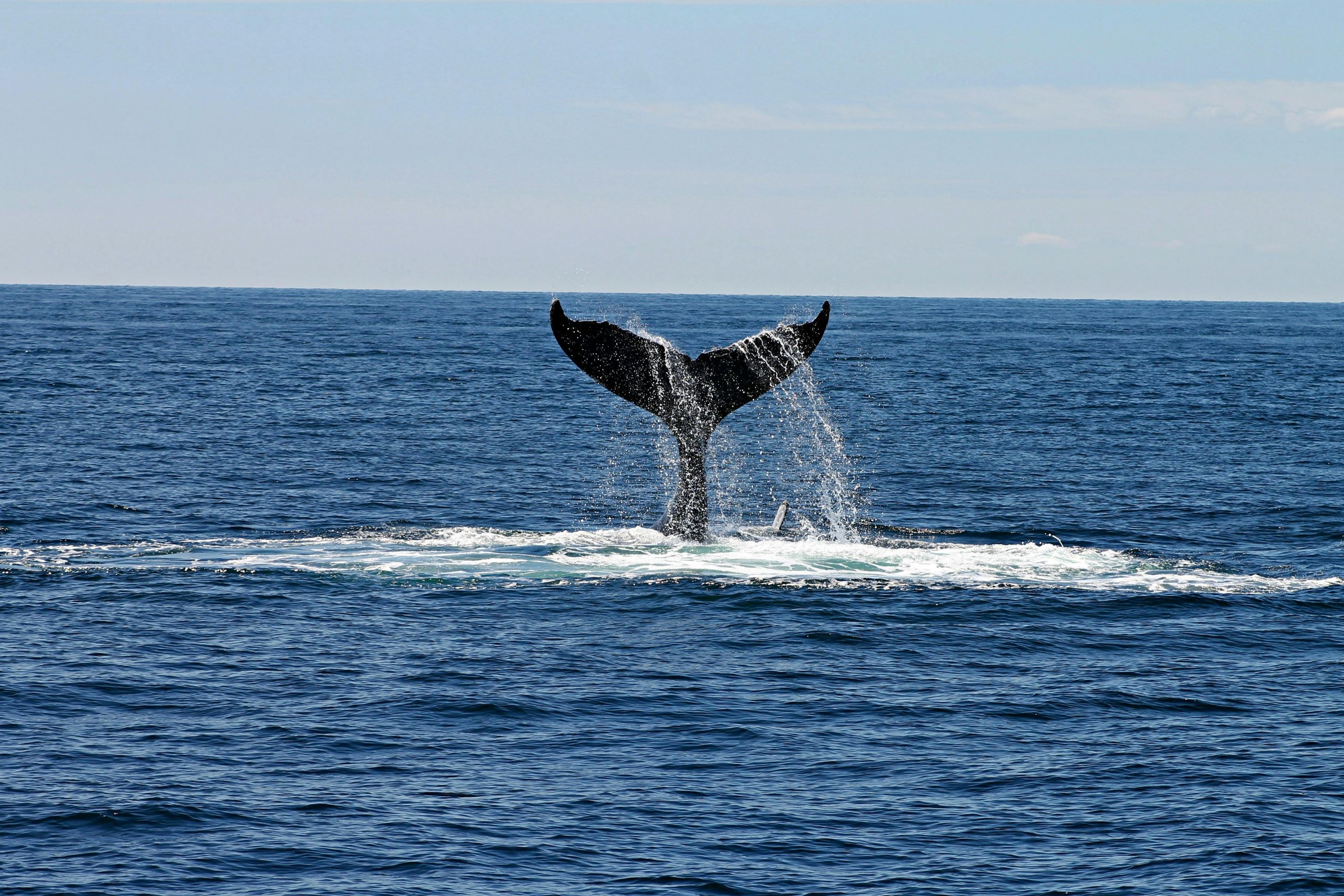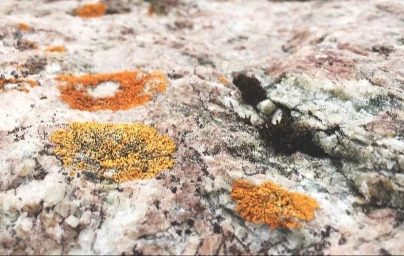Whales of Antarctica: Vital Roles and Unique Adaptations
The icy waters surrounding Antarctica provide vital feeding grounds for many whale species. These resilient animals thrive in one of Earth’s most extreme environments. The nutrient-rich Southern Ocean supports abundant marine life, offering ample food for species ranging from the colossal blue whale to the agile orca. Each plays a key role in maintaining the balance of the Antarctic ecosystem.
Whales in this region show remarkable adaptations and behaviours. Orcas are divided into several ecotypes, each with distinct hunting methods and preferred prey. This diversity reflects the fine balance of life beneath the surface of the Southern Ocean.
Humpback whales, recognised for their dramatic breaching, are frequently seen in Antarctic waters. Blue and fin whales roam the open seas in search of krill, their main food source. Sperm whales, adapted for deep diving, hunt giant squid in deeper waters. Together, these species reveal the richness and complexity of Antarctica’s marine world.
Click on the links below to jump to each species
Indicators of Marine Health
These cetaceans are not only essential to Antarctica’s biodiversity but also serve as indicators of the health of global ocean ecosystems. Their migrations, covering thousands of kilometres, demonstrate remarkable survival strategies, connecting distant ecosystems and underscoring the interconnected nature of marine environments. Observing their presence in the Southern Ocean offers scientists insights into the broader health of marine systems worldwide.
The abundance of whales in Antarctic waters highlights the region’s importance as a critical habitat for marine life, underscoring the need for international conservation efforts. These majestic creatures serve as sentinels of ocean health, making their preservation crucial for sustaining the biodiversity of Antarctic waters. Conservation efforts aimed at protecting these species are essential for maintaining the balance of the Southern Ocean, ensuring that this unique ecosystem thrives for future generations.
WWF Report on Whales in the Antarctic Peninsula
In collboration with UC Santa Cruz, the WWF has produced a fantastic report about the whales of the Antarctic Peninsula. The report details:
- The lasting effects of whaling
- Feeding habits of whales
- Migration information
- The Threats facing whales
- The use of technology to track whales
- The use of cruise ship tourism to assist with studie of whales
Click on the image to open the report.
Antarctic Humpback Whales (Megaptera novaeangliae)
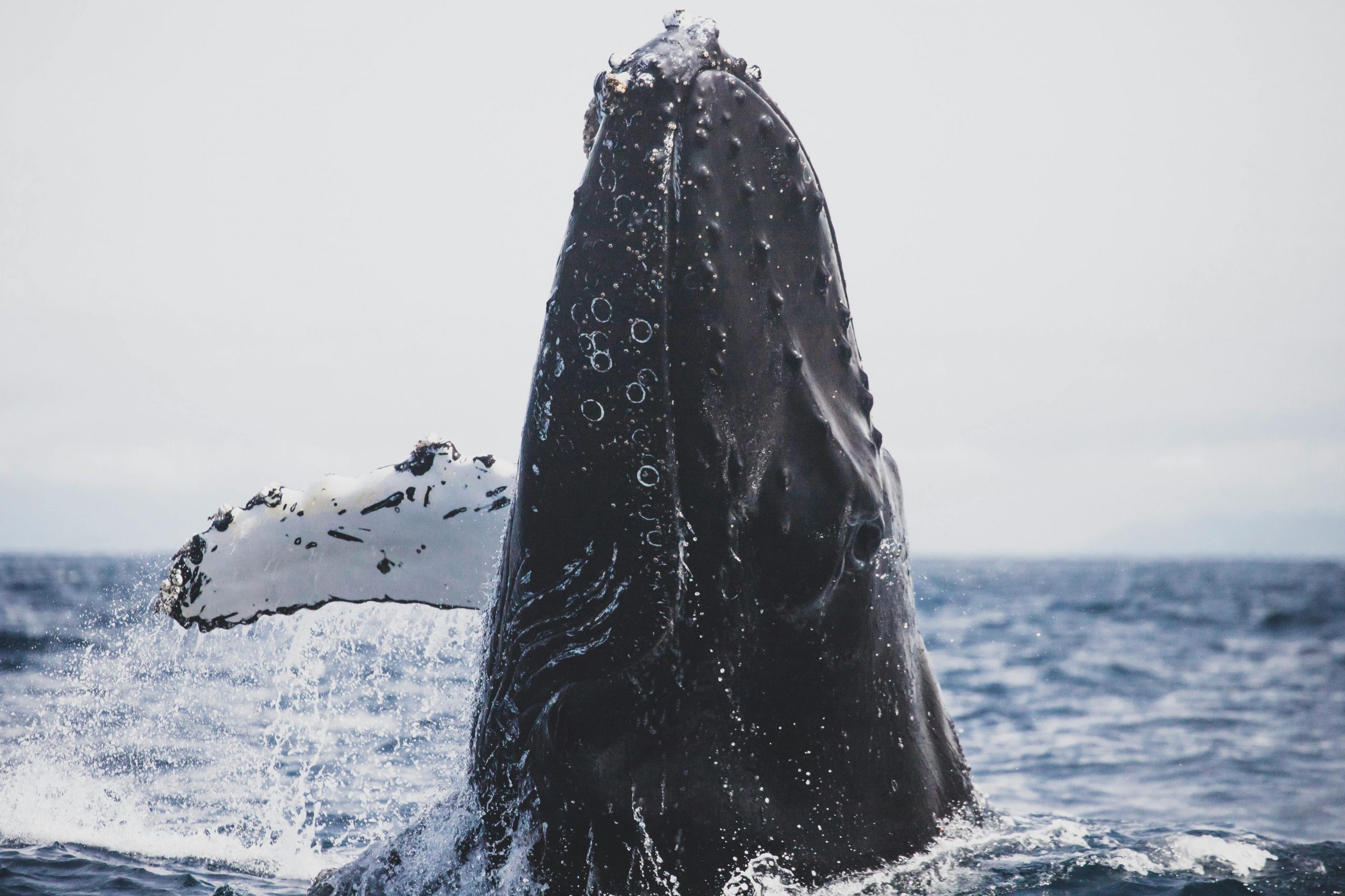
Humpback whales are integral to the Southern Ocean ecosystem. These massive, migratory mammals are known for their unique feeding techniques, including bubble-net feeding, which involves creating bubbles to trap krill and small fish. During the Antarctic summer, humpbacks journey to these nutrient-rich waters to build up fat reserves for their breeding season in warmer climates.
Humpback whales’ distinctive behaviours, including complex songs and acrobatic breaches, make them some of the most studied and recognisable whale species. Their presence is vital to the Antarctic food web, linking predator and prey dynamics. However, the species faces pressures from climate change, which affects krill populations, and from past over-hunting. Today, conservation efforts aim to ensure that humpbacks continue to thrive, maintaining the balance of Antarctic marine ecosystems.
Appearance
Antarctic humpback whales are instantly recognisable by their enormous size, long pectoral fins, and distinct body shape. Adults typically reach lengths of 14 to 17 meters (46 to 56 feet) and weigh up to 40 tonnes. Their backs are primarily black, contrasting with unique white patterns on their pectoral fins and undersides, which serve as identifying marks akin to fingerprints.
The head and jaw are covered in tubercles—small, knob-like structures—each containing a single hair follicle, believed to aid in sensory perception. This combination of physical features makes them visually distinctive among whale species.
Behaviour
Humpback whales are known for their captivating displays, including breaching (leaping out of the water), lobtailing (slapping their tails on the surface), and flipper-slapping. These behaviours may have multiple functions, such as communication, feeding assistance, and parasite removal.
Additionally, humpbacks are renowned for their complex songs, which can last up to 20 minutes. These vocalisations are thought to play a role in mating rituals and social bonding within groups, showcasing the whales’ intricate communication abilities and making them a favourite among whale watchers.
Diet
The diet of Antarctic humpback whales consists almost entirely of krill, small shrimp-like crustaceans that swarm in large numbers during the Antarctic summer. To capture krill efficiently, humpbacks use a cooperative feeding technique known as bubble-net feeding.
In this coordinated behaviour, multiple whales swim beneath a school of krill, releasing bubbles to create a “net” that confines their prey. They then swim upward with mouths open, engulfing the concentrated mass of krill. This behaviour highlights the complex social interactions and feeding adaptations that allow humpbacks to thrive in the nutrient-rich waters of the Southern Ocean.
Reproductive Cycle
The breeding cycle of humpback whales is closely tied to their migratory patterns. Mating and birthing occur in warm tropical and subtropical waters during the winter months. After an 11-month gestation period, females give birth to a single calf.
The mother nurses the calf for about a year, providing rich milk that helps the young whale develop the strength needed for the long journey back to Antarctic waters. This strong mother-calf bond is crucial for the calf’s survival, as it must quickly grow and gain essential skills during its first year.
Habitat & Range
During the Antarctic summer, humpback whales populate the Southern Ocean, gathering in areas where krill densities are highest. As winter approaches and Antarctic waters cool, the whales embark on their northward migration to warmer, equatorial regions for breeding.
This annual migration cycle, with whales often returning to the same feeding and breeding areas each year, underscores their strong navigational instincts and the importance of specific habitats for their life cycle.
Ecological Role
The Antarctic humpback whale exemplifies the marvels of marine migration and adaptation, illustrating both the physical endurance required for long-distance travel and the critical need for international conservation. Protecting these gentle giants and their habitats is essential for the health of broader marine ecosystems.
As symbols of oceanic resilience and interconnectedness, humpback whales underscore the importance of coordinated global efforts to ensure the preservation of the world’s oceans and the countless species that depend on them.
Antarctic Blue Whales (Balaenoptera musculus intermedia)
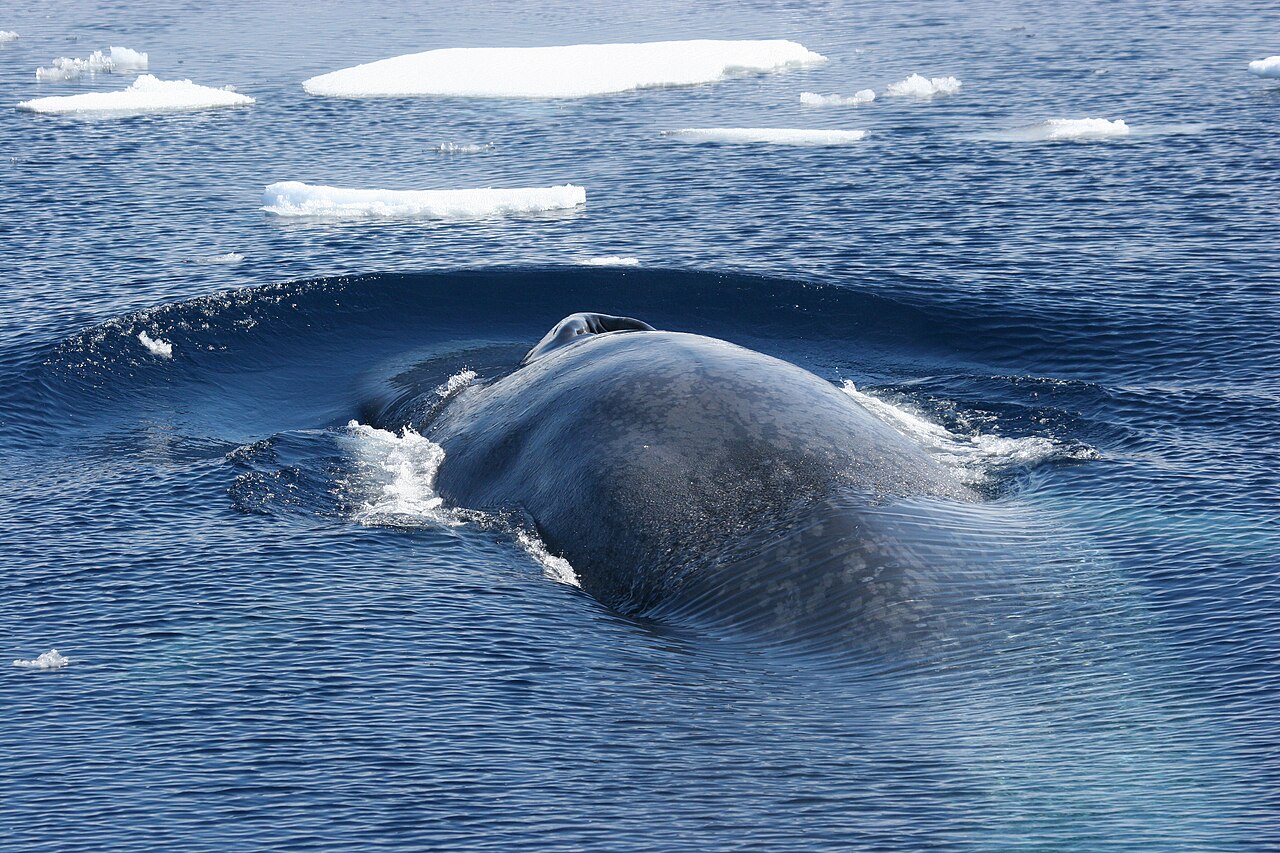
Among the whales of Antarctica, the blue whale stands as the largest animal on Earth, embodying power and grace within the Southern Ocean. Feeding predominantly on krill, blue whales consume vast quantities each day, playing a crucial role in maintaining ecological balance. The cold, nutrient-rich waters around Antarctica provide an ideal feeding ground, where blue whales build energy reserves for their extensive migrations.
Known for their low-frequency calls that can travel great distances, blue whales are also central to scientific research on marine acoustics. Despite international protection, blue whale populations remain critically low due to historic over-hunting. Climate change poses additional threats by impacting krill populations, their primary food source.
Ongoing conservation efforts focus on habitat protection and further studies to ensure blue whale populations can recover and sustain their essential role in Antarctic marine ecosystems.
Appearance
Antarctic blue whales are the largest animals on Earth, reaching staggering lengths of up to 30 meters (98 feet) and weighing approximately 180 tonnes. Their bodies are long and slender, with a mottled blue-grey colour that gives them an almost ethereal blue appearance underwater.
Distinctive features include a broad, flat head and a prominent ridge along their back just behind the small dorsal fin, adding to their unique and iconic profile. This immense size and streamlined body allow them to traverse vast distances across the ocean with remarkable efficiency, a necessity given their enormous nutritional needs.
Behaviour
Unlike other whales, blue whales are generally solitary or found in small groups, displaying fewer acrobatic behaviours. Instead, they are known for their deep, powerful vocalisations—the loudest animal sounds ever recorded.
These prolonged calls can be heard hundreds of miles away, serving as essential tools for long-range communication and navigation across the vast Southern Ocean. Scientists believe these calls help blue whales locate each other over great distances and may assist with navigating the open ocean.
This vocal ability underscores the incredible adaptation of blue whales to life in expansive marine environments where visibility is limited.
Diet
The diet of Antarctic blue whales consists almost exclusively of krill, which they consume in tremendous quantities. Each day, a blue whale may consume several tonnes of krill to sustain its massive body.
Blue whales are gulp feeders, using a unique technique to feed efficiently. They take in large volumes of krill-laden water, then push the water back out through their baleen plates, trapping the krill inside.
This feeding method enables them to capture vast amounts of food in each gulp, supporting their high energy requirements during the summer feeding season in the nutrient-rich waters of the Southern Ocean.
Reproductive Cycle
Due to their elusive nature, much of the reproductive behaviour of blue whales remains a mystery. It is believed that they follow a two- to three-year breeding cycle. Females typically give birth to a single calf every two to three years following a gestation period of about 12 months.
The calf, born already weighing several tonnes, receives hundreds of litres of nutrient-rich milk each day from its mother. This intense nursing period lasts around six months, during which the calf grows rapidly, preparing for the demanding migratory life of a blue whale.
Habitat & Range
During the Antarctic summer, blue whales gather in the Southern Ocean, where krill is abundant, to fuel their immense bodies. As winter approaches, they migrate towards the equator in search of warmer waters.
However, not all individuals make the full migration northward, and their exact migratory routes remain partly unknown due to the challenges of studying these massive creatures in remote oceanic expanses.
The mysteries surrounding their migratory behaviour continue to intrigue scientists, as these patterns hold important clues about the ecological needs of the species.
Ecological Role
The Antarctic blue whale, with its immense size and haunting calls, represents the untamed spirit of the Antarctic seas. Conservation of this iconic species is a global priority, as blue whale populations have struggled to recover from historical whaling.
Their protection highlights the critical importance of international marine protection treaties and ongoing research efforts. Preserving Antarctic blue whales is essential not only for their survival but also for the health of the Southern Ocean ecosystem, where they play a pivotal role.
Protecting these giants supports marine biodiversity and fosters an understanding of the interconnectedness of global oceanic systems.
Antarctic Fin Whales (Balaenoptera physalus)
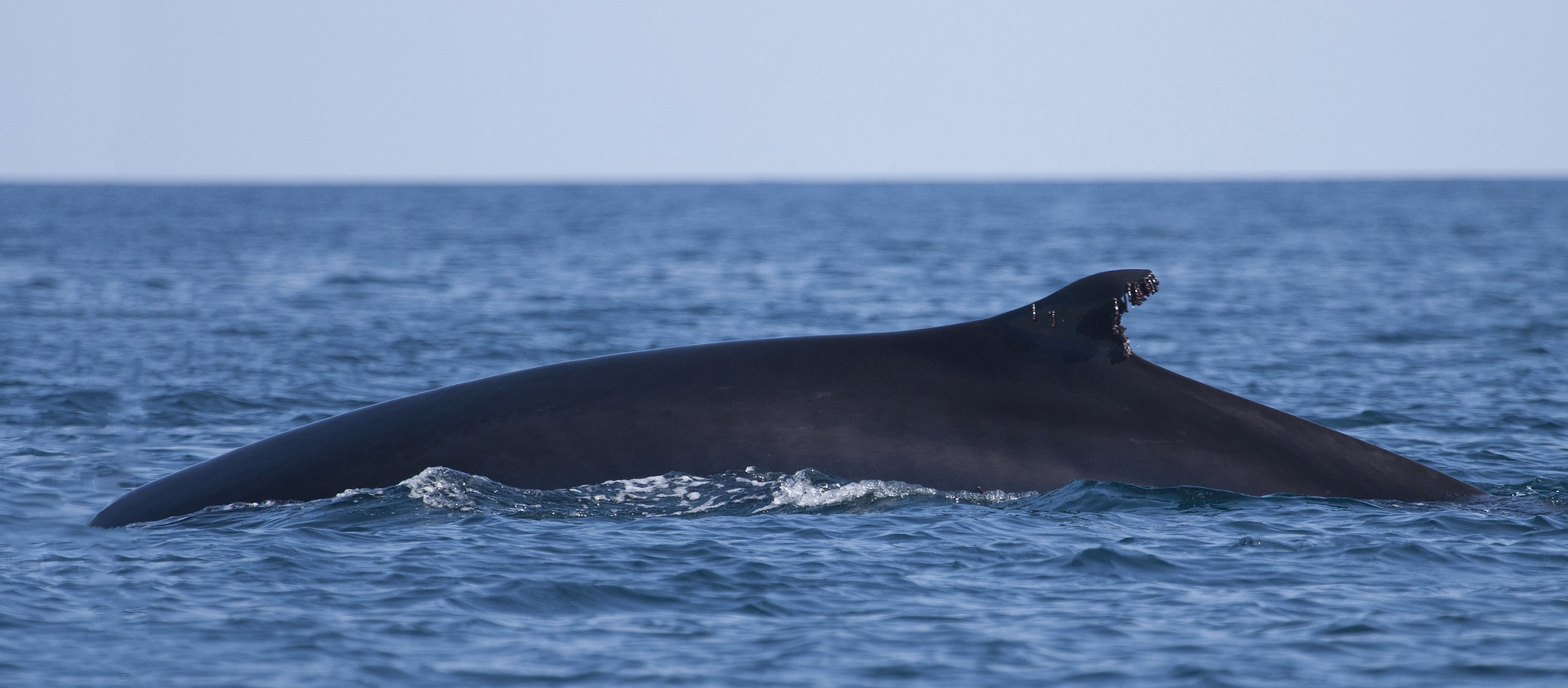
The Southern Ocean provides a crucial habitat for the whales of Antarctica, particularly the Antarctic fin whale, the second-largest creature on Earth after the blue whale. These giants navigate the polar marine environment, playing a vital role in the ecological dynamics of Antarctica.
Known for their impressive size, remarkable speed, and distinctive jaw coloration, Fin whales contribute significantly to the marine food web by preying on large quantities of small fish, squid, and krill. Their presence underscores the biodiversity of the Antarctic ecosystem and the importance of maintaining its delicate balance.
Appearance
Antarctic fin whales, one of the most prominent whales in Antarctica, have sleek, streamlined bodies, reaching lengths of up to 22 meters (72 feet) and weighing as much as 80 tonnes. Their name comes from their distinctive dorsal fin located about two-thirds down their back.
One striking feature of these whales is the asymmetrical coloration of their jaws—black on the left side and white on the right. This unique coloration, along with their baleen plates used for filtering food, aids in identifying individuals and supports their feeding strategies.
Their blow, or spout, can reach up to 6 meters (20 feet), making them easy to spot in the Southern Ocean.
Behaviour
Among the fastest whales in Antarctica, Antarctic fin whales have earned the nickname “greyhounds of the sea” due to their impressive swimming speeds.
They are known for long, deep dives that can last several minutes as they search for prey. Typically solitary, they may gather in small groups in food-rich areas, showcasing their adaptability and social flexibility.
This dynamic behaviour enables them to cover vast distances and find ample food across the Southern Ocean, a testament to their adaptability in Antarctica’s challenging waters.
Diet
As one of the key whales in Antarctica, Antarctic fin whales primarily feed on krill, small schooling fish, and squid. They rely on a side-swimming technique to engulf large swarms of prey, filtering water through their baleen plates to trap food.
This efficient feeding strategy allows them to consume several tonnes of food daily during the Antarctic summer, building reserves for migration and reproduction.
By consuming such large amounts of prey, these whales play a critical role in maintaining balance within the Antarctic marine ecosystem.
Reproductive Cycle
The reproductive cycle of the fin whale involves a gestation period of around 11 to 12 months, with females birthing a single calf every two to three years in warmer waters. This reproductive strategy allows newborns to avoid the intense cold of Antarctica, as they are initially dependent on their mother’s rich milk for survival.
After approximately six to seven months, the calves are weaned and gain the strength needed to undertake the journey back to the Antarctic feeding grounds.
Habitat & Range
During the Antarctic summer, whales in Antarctica such as fin whales are found primarily in ice-free areas of the Southern Ocean, where krill and other marine life are abundant. As winter approaches, these whales migrate to warmer waters for breeding, underscoring their role in connecting ecosystems across polar and tropical regions.
Their migratory behaviour highlights the interconnectedness of global ocean systems, as these long-distance journeys contribute to nutrient cycling and ecosystem stability.
Ecological Role
Conservation of whales in Antarctica requires international collaboration, as these populations face threats from climate change, pollution, and historical population declines.
Protecting these whales and their habitats is essential not only for their survival but also for maintaining biodiversity in the Southern Ocean. Efforts to preserve these keystone species are crucial for safeguarding the health and resilience of the Antarctic marine ecosystem.
Sei Whales (Balaenoptera borealis)
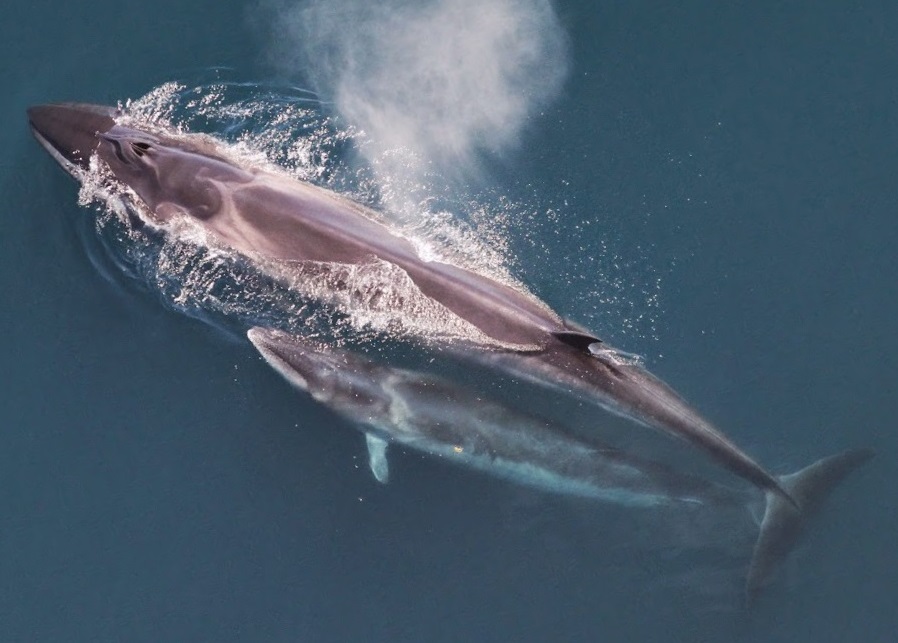
Of all the whales in Antarctica, the Antarctic sei whale is an expert in navigating the boundary between ice and open sea. Belonging to the baleen whale family, these whales are among the fastest of the large whale species, covering great distances in their search for food.
Their presence highlights the richness and diversity of marine life in Antarctic waters and underscores the importance of conservation efforts to protect these magnificent animals and their habitat.
Appearance
The Antarctic sei whale is a large, streamlined whale, reaching lengths of up to 19.5 meters (64 feet) and weighing as much as 28 tonnes. Its back is dark steel grey with a lighter underside, and it features a tall, hooked dorsal fin positioned about two-thirds of the way down its body.
One distinguishing characteristic of the sei whale is the series of longitudinal grooves, or pleats, along its throat, which expand to allow the whale’s mouth to widen significantly during feeding. These adaptations are essential for the sei whale’s efficient filter-feeding method and contribute to its sleek and graceful appearance among whales in Antarctica.
Behaviour
Sei whales are known for their speed and agility, reaching swimming speeds of up to 50 kilometres per hour (31 miles per hour), making them one of the swiftest whales in Antarctica. Primarily solitary, they occasionally form small, temporary groups in areas where food is abundant.
Unlike some baleen whales, sei whales do not typically exhibit acrobatic behaviours like breaching but are often observed skim-feeding at the water’s surface. This surface-feeding behaviour provides a rare glimpse of their unique feeding methods in Antarctic waters.
Diet
The diet of the Antarctic sei whale consists mainly of krill, copepods, and small fish, aligning with the nutrient-rich conditions of the Southern Ocean.
As opportunistic feeders, sei whales often feed at or near the surface, using their baleen plates to filter food from the water. This efficient feeding strategy allows them to consume several tonnes of food each day during the feeding season, building the reserves they need for long migrations and supporting their role within the Antarctic marine food web.
Reproductive Cycle
Sei whales mate and give birth in warmer, subtropical waters during the winter months, as is common among whales in Antarctica. Females have a gestation period of approximately 11 months and give birth to a single calf, which they nurse for 6 to 9 months.
The young whale gradually transitions to independent feeding on plankton and begins the migratory lifestyle characteristic of its species. This reproductive cycle ensures that calves are nurtured in warmer waters, where they are better protected during their early months.
Habitat & Range
While sei whales are found throughout many of the world’s oceans, their presence in the Southern Ocean is concentrated in the ice-free zones and along the Antarctic Convergence, where cold and warm waters mix to create nutrient-rich feeding grounds.
Each year, sei whales undertake extensive migrations from low-latitude breeding grounds to high-latitude feeding areas in Antarctica, a pattern typical among whales in Antarctica. These migrations connect ocean ecosystems, demonstrating the global interconnectedness of marine environments.
Ecological Role
The Antarctic sei whale, with its elegant form and impressive speed, plays a vital yet understudied role in the Southern Ocean’s ecosystem. As one of the significant whales in Antarctica, its feeding patterns and migrations provide valuable insights into the health of oceanic ecosystems and the abundance of prey species.
Conservation efforts aimed at protecting sei whales and their habitat are essential for sustaining the intricate Antarctic marine food web, where each species contributes to ecological balance.
Protecting whales in Antarctica, such as the sei whale, remains crucial not only for the preservation of these majestic creatures but also for the broader health of the Southern Ocean. Ensuring the survival of the sei whale is a step toward maintaining the biodiversity and stability of one of the planet’s most delicate and essential ecosystems.
Southern Right Whales (Eubalaena australis)
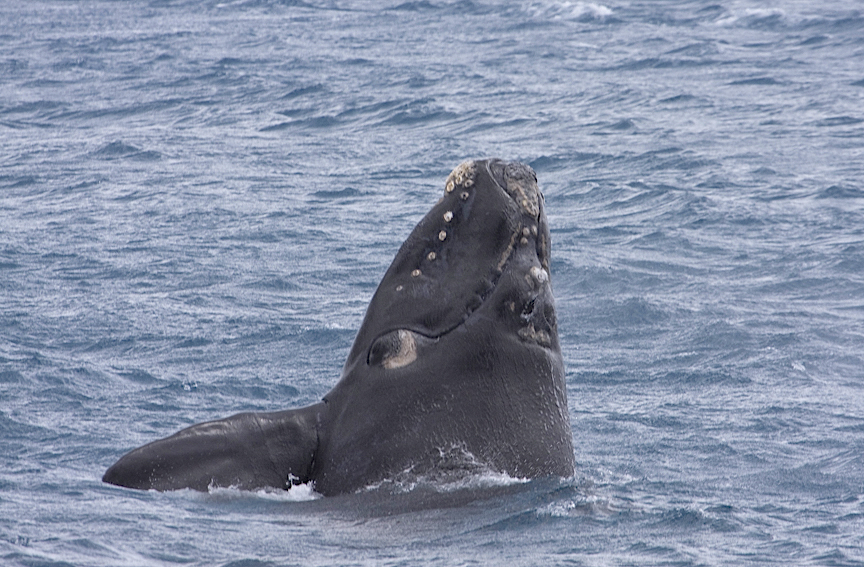
Southern right whales are among the most majestic and vulnerable whales in Antarctica and the world’s oceans. Known for their massive, robust bodies, broad backs without dorsal fins, and distinctive callosities on their heads, these gentle giants are a captivating sight in their natural habitats.
Historically, they were called the “right” whales to hunt due to their slow swimming speeds, tendency to float when killed, and high blubber content, making them particularly valuable to hunters.
Today, Southern right whales are protected under international law, yet they still face threats from ship strikes and entanglements in fishing gear. Conservation of these whales is crucial—not only for their intrinsic value but also for their important ecological role, as they contribute to marine health through their feeding activities. Protecting right whales allows scientists to monitor the health of marine ecosystems, emphasizing the interconnectedness of ocean life and the need for comprehensive conservation efforts.
Appearance
Southern right whales are recognisable by their large, black bodies, lack of a dorsal fin, and uniquely arched rostrums. Reaching lengths of up to 18 meters (59 feet) and weighing as much as 100 tonnes, they are one of the larger whales of Antarctica.
Their heads are marked by callosities—rough patches of skin that host “whale lice” or cyamids—which form unique patterns, aiding in individual identification. Southern right whales also possess long baleen plates used for filtering food from seawater, and their broad, paddle-shaped flippers are proportionally shorter than those of other whale species.
Behaviour
Southern right whales are relatively slow swimmers, typically moving at about 5 km/h (3 mph), although they can speed up briefly when needed. They are known for engaging in surface-active behaviours, such as breaching, tail-slapping, and “head-standing.”
These whales are often solitary or seen in small groups, particularly mothers with calves. Their vocalizations are thought to aid in communication and possibly navigation, adding to their complex behavioural repertoire. Observing these behaviours offers valuable insights into the social dynamics of whales in Antarctica and the factors that influence their migratory patterns.
Diet
The diet of Southern right whales consists primarily of zooplankton and small fish, which they capture using their baleen plates as sieves. Right whales feed by swimming slowly through dense patches of plankton with their mouths open, allowing water to pass through the baleen and trapping food.
This efficient feeding strategy sustains them during their time in the nutrient-rich waters of Antarctica and demonstrates their adaptation to the Southern Ocean’s unique conditions.
Reproductive Cycle
Southern right whales have a low reproductive rate, with females typically birthing a single calf after a gestation period of about 12 months. Calving occurs every three to five years, creating strong mother-calf bonds that are essential for the calf’s survival.
During the first year, the mother nurses the calf with rich, fatty milk, allowing it to grow rapidly and develop the strength needed for survival. This extended care period reflects the species’ vulnerability and the importance of protected breeding grounds for the whales of Antarctica.
Habitat & Range
Southern right whales inhabit temperate to subpolar waters, with their range extending across the North Atlantic, North Pacific, and Southern Oceans, depending on the species. They are migratory, spending summers in cooler, high-latitude feeding grounds and moving to warmer, low-latitude breeding grounds in the winter.
Their preference for coastal habitats, however, makes them more susceptible to human activities, underscoring the need for protective measures in both their feeding and breeding areas.
Ecological Role
The preservation of Southern right whales exemplifies a global commitment to marine conservation and highlights the challenges of protecting migratory species that cross national and international boundaries. Key conservation efforts include reducing ship speeds in critical habitats and developing fishing gear designed to prevent entanglements.
These measures are essential for sustaining the health of whales in Antarctica and maintaining the biodiversity of marine ecosystems.
As indicators of ocean health and biodiversity, the survival of Southern right whales reflects broader environmental stewardship. The fate of these remarkable creatures reminds us of our shared responsibility to protect the oceans and the life they support. Conservation efforts aimed at safeguarding the whales of Antarctica are vital to ensuring that these ecosystems remain vibrant for generations to come.
Sperm Whale (Physeter macrocephalus)
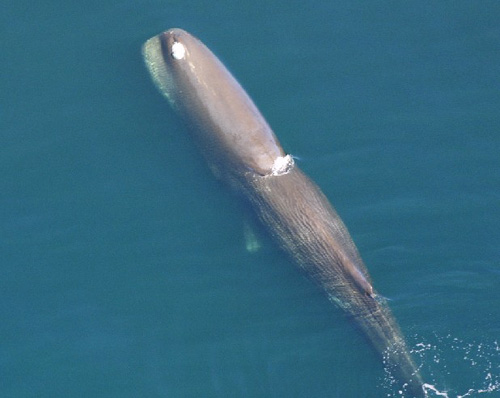
Sperm whales, the largest of the toothed whales, dominate the depths of the Southern Ocean with their distinct adaptations and formidable size. Recognised for their uniquely block-shaped heads, which house the largest brain of any known species, sperm whales embody the peak of marine mammalian evolution. Their role in Antarctic waters is critical, as they underscore the region’s complex biodiversity and reveal the ecological importance of the Southern Ocean as a habitat capable of supporting apex predators.
Within the Antarctic ecosystem, sperm whales exert substantial influence through their predation on squid populations, including the colossal squid. By preying on these deep-sea species, they play a key role in maintaining the balance of marine food webs. Sperm whales’ ability to dive to extreme depths illustrates their biological specialisation, allowing them to reach habitats inaccessible to most marine species. Protecting sperm whales and their environment is crucial for sustaining the health and diversity of Antarctic marine ecosystems, reflecting the interconnected nature of global oceanic life.
Appearance
Sperm whales are easily recognisable by their massive heads, which comprise about one-third of their entire body length. Adult males can grow up to 20 meters (66 feet) in length and weigh over 50 tonnes, making them one of the largest predators among the whales of Antarctica.
Their skin is wrinkled and ranges from dark grey to black, with white patches often visible on the belly. The narrow lower jaw holds large, conical teeth that fit into sockets in the upper jaw, a distinctive feature that enhances their ability to hunt large prey.
Behaviour
Sperm whales are exceptional deep divers, capable of plunging to depths exceeding 2,000 meters (6,560 feet) and staying submerged for up to 90 minutes while hunting. Known for their strong social bonds, sperm whales form matrilineal pods composed of females and young, while adult males often live solitary lives or join bachelor groups.
These whales in Antarctica communicate using a complex system of clicks and codas, which serve crucial functions in navigation, foraging, and social interaction in the dark depths of the ocean. This intricate social behaviour enhances their survival and provides insight into the sophisticated communication systems of marine mammals.
Diet
The diet of sperm whales is dominated by medium to large-sized squid, including the colossal squid, with fish and other deep-sea organisms also supplementing their diet.
Sperm whales use echolocation to detect prey in the pitch-black waters of the deep sea, an advanced hunting technique that enables them to find food in one of the ocean’s most challenging environments. By consuming large quantities of squid, sperm whales maintain balance within the Antarctic marine ecosystem, illustrating the vital ecological role that whales in Antarctica play.
Reproductive Cycle
Female sperm whales give birth to a single calf after a gestation period of approximately 15 months. Calves are nursed for several years, though they may remain with their mother’s pod for much longer, benefiting from the protection and social structure of the group.
Sperm whales have a prolonged maturation process, with males reaching full size around 50 years of age. This extended developmental period underscores the vulnerability of the species and the importance of conserving their habitats to ensure population stability.
Habitat & Range
Sperm whales are found in all the world’s oceans, from the Arctic to the Antarctic. In Antarctic waters, they typically inhabit ice-free zones, pursuing large squid species that thrive in the cold, nutrient-rich waters.
Their distribution is closely tied to prey availability, making the Antarctic Convergence—a region where ocean currents meet and concentrate marine life—a frequent destination. This seasonal movement highlights the importance of Antarctic waters as a feeding ground for whales in Antarctica.
Ecological Role
The sperm whale’s remarkable adaptations to the extreme conditions of Antarctic waters exemplify the marvels of evolutionary biology and highlight the intricate relationships within marine ecosystems. Protecting these leviathans and their environment is essential, not only for preserving biodiversity but also for understanding the complex web of life that sustains ocean health.
As indicators of ocean health and symbols of humanity’s deep connection with the sea, whales in Antarctica, like the sperm whale, embody the awe-inspiring nature of the marine world and underscore the urgent need for conservation.
Ensuring the survival of sperm whales in Antarctica reflects our global commitment to preserving marine ecosystems and maintaining the biodiversity that supports a healthy ocean. Conservation efforts are vital for protecting these majestic creatures and the interconnected ecosystems they inhabit, safeguarding one of the planet’s most delicate and essential marine environments for future generations.
Antarctic minke whales (Balaenoptera bonaerensis)
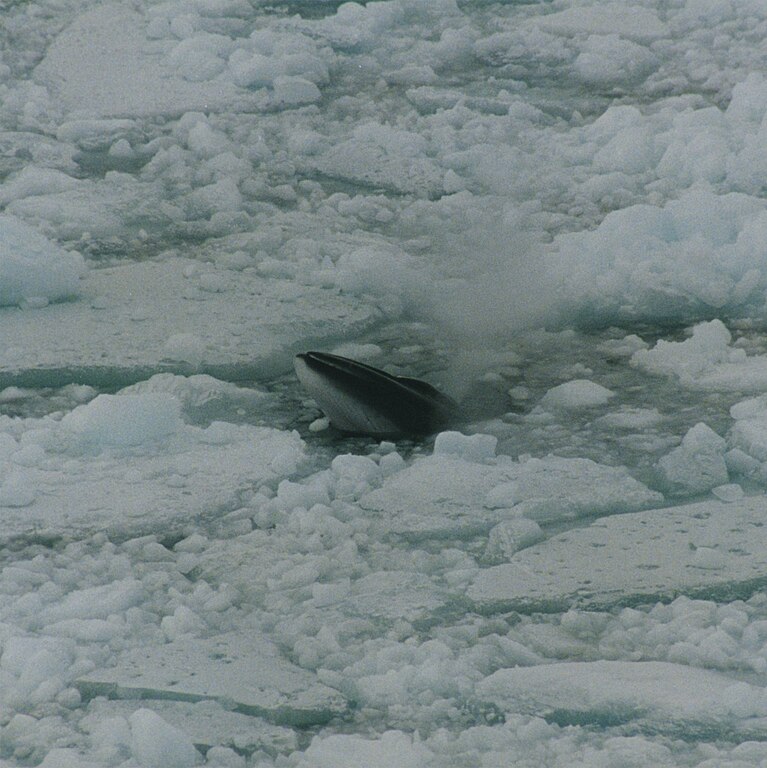
Antarctic minke whales, a distinct subspecies of the minke whale, are uniquely adapted to one of the most extreme environments on Earth: the Southern Ocean. These whales are a fascinating blend of resilience and adaptability, inhabiting a habitat marked by intense cold, vast ice formations, and some of the world’s most seasonal food sources.
Unlike many other large baleen whales, Antarctic minkes exhibit remarkable agility, endurance, and specialisation in hunting Antarctic krill, the keystone species of this remote ecosystem. This makes them integral not only to the Antarctic food web but also to the delicate balance of marine biodiversity in the polar regions.
While Antarctic minke whales are relatively smaller than their baleen counterparts, they have evolved to survive—and thrive—in icy waters that pose severe challenges for most other marine species. Their lifestyle is a testament to biological adaptability, from their streamlined physiques and efficient feeding mechanisms to their ability to migrate great distances annually.
They migrate seasonally, spending summers in the frigid waters of the Antarctic for intense feeding periods before travelling to more temperate regions for breeding. This annual journey between feeding and breeding grounds reflects a life cycle finely tuned to the rhythm of the Antarctic seasons.
In recent decades, Antarctic minke whales have drawn significant attention from researchers and conservationists. Rising global temperatures, shifts in sea ice, and human activity in polar regions present new challenges that could alter the fragile Antarctic ecosystem. Understanding the role of Antarctic minke whales within this system, including their behavioural patterns, feeding strategies, and reproductive cycles, is crucial for developing informed conservation efforts.
Appearance
Antarctic minke whales exhibit a streamlined, torpedo-like form that allows them to move swiftly through icy waters. Adult whales typically range from 7.5 to 10 metres in length, with females generally larger than males, weighing between 5 and 10 tonnes. Their bodies display a striking contrast between the dark, almost black colouration on the back and the lighter, greyish-white underside. This counter-shading likely serves as camouflage, helping them blend into the dark depths below when viewed from above and the brighter surface waters from below.
One of their most distinguishing features is a broad, white band around the middle of each pectoral fin. These “armbands” are unique among baleen whales and are particularly pronounced in Antarctic minkes. Researchers theorise that this feature might help them startle or confuse prey, while also enhancing their stealth against potential predators by disrupting their outline in the water.
Behaviour
Typically solitary, Antarctic minke whales are known for their quiet and elusive nature, usually seen alone or in pairs. However, in areas with abundant prey, they may gather in larger groups, forming temporary feeding aggregations. Their agility in the water sets them apart from other baleen whales; they are capable of reaching impressive speeds of up to 24 km/h, which helps them evade predators, such as orcas, that roam Antarctic waters.
Their diving behaviour is notable, as they often submerge for 3 to 8 minutes, reaching depths of around 100 metres. They perform deep dives to access dense krill swarms beneath the ice, sometimes diving even deeper during prolonged foraging sessions. Some individuals are known to engage in “spyhopping” – a behaviour where they vertically raise their heads above the water surface, possibly to survey their surroundings or assess potential threats, a remarkable feat for these relatively reclusive animals.
Diet
As filter feeders, Antarctic minke whales primarily consume krill, specifically *Euphausia superba*, which dominates the Southern Ocean’s ecosystem. During the austral summer, krill swarms become highly concentrated around the edges of pack ice, providing a seasonal bounty for minke whales. Using specialised baleen plates – which can number between 230 and 360 on each side of the mouth – they gulp large volumes of water and then expel it, trapping krill on the fine bristles of the baleen. This feeding technique is energy-efficient, enabling them to consume vast quantities of krill quickly and efficiently.
On average, an Antarctic minke whale can consume up to 3-5% of its body weight in krill daily during peak feeding season, allowing it to build significant fat reserves. These reserves sustain the whales during their northward migration in the winter months, when food is less abundant. Their feeding strategy is timed to coincide with krill’s lifecycle, underscoring the interdependence between minke whales and the Antarctic ecosystem.
Reproductive Cycle
Antarctic minke whales have a defined reproductive cycle tailored to the challenges of their environment. Mating typically occurs during the winter, with females carrying a single calf after a gestation period of approximately 10 months. This cycle ensures that calves are born in warmer, lower-latitude waters around late winter or early spring, where conditions are less severe.
Newborn calves measure around 2.5 to 2.8 metres in length and weigh approximately 400 kilograms. Calves nurse for about six months, gaining substantial weight and energy from the mother’s nutrient-rich milk, which has a fat content of over 40%. This rapid early development is crucial, as calves must be strong enough to accompany their mothers on their return to the icy feeding grounds in Antarctica. Females reach sexual maturity between seven and ten years of age, with a typical interval of one to two years between pregnancies.
Habitat & Range
The Antarctic minke whale is highly specialised for life in the Southern Ocean, a habitat characterised by extreme cold, high winds, and seasonal ice cover. During the austral summer, they inhabit the frigid waters around Antarctica, preferring areas near the pack ice, where they can access rich feeding grounds and potentially find protection from predators. Their tolerance for cold allows them to exploit regions inaccessible to many other marine species, including areas beneath the ice, where they sometimes forage by swimming under ice floes to reach krill swarms.
When the Antarctic winter sets in, minke whales migrate northward, although the precise migration patterns and destinations remain somewhat mysterious, as they tend to disperse into broader, warmer regions in search of temperate waters. Some may travel as far as the coasts of South America, South Africa, and Australia, although their migratory range is not as extensive as some larger baleen whale species.
Ecological Role
Antarctic minke whales hold a critical ecological role as krill predators, helping to regulate the krill population and influence the structure of the Antarctic marine food web. By consuming krill in vast quantities, they indirectly support the balance of species that rely on krill, such as fish and birds. However, their population faces threats from climate change, as warming waters and declining sea ice may disrupt krill abundance, directly affecting the feeding success of minke whales.
Despite their relatively stable numbers, Antarctic minke whales have been subject to whaling activities in the past, and limited commercial hunting continues today under certain national regulations. Conservation efforts, focusing on the preservation of their habitats and krill populations, are essential to ensure their long-term survival in a rapidly changing polar environment.
In conclusion, Antarctic minke whales exemplify adaptation to a challenging environment, showcasing physical, behavioural, and migratory adaptations that allow them to thrive in the Southern Ocean. Their ecological significance, especially in maintaining Antarctic food web dynamics, underscores the importance of protecting these resilient cetaceans amidst environmental change.
Orca (Orcinus orca)
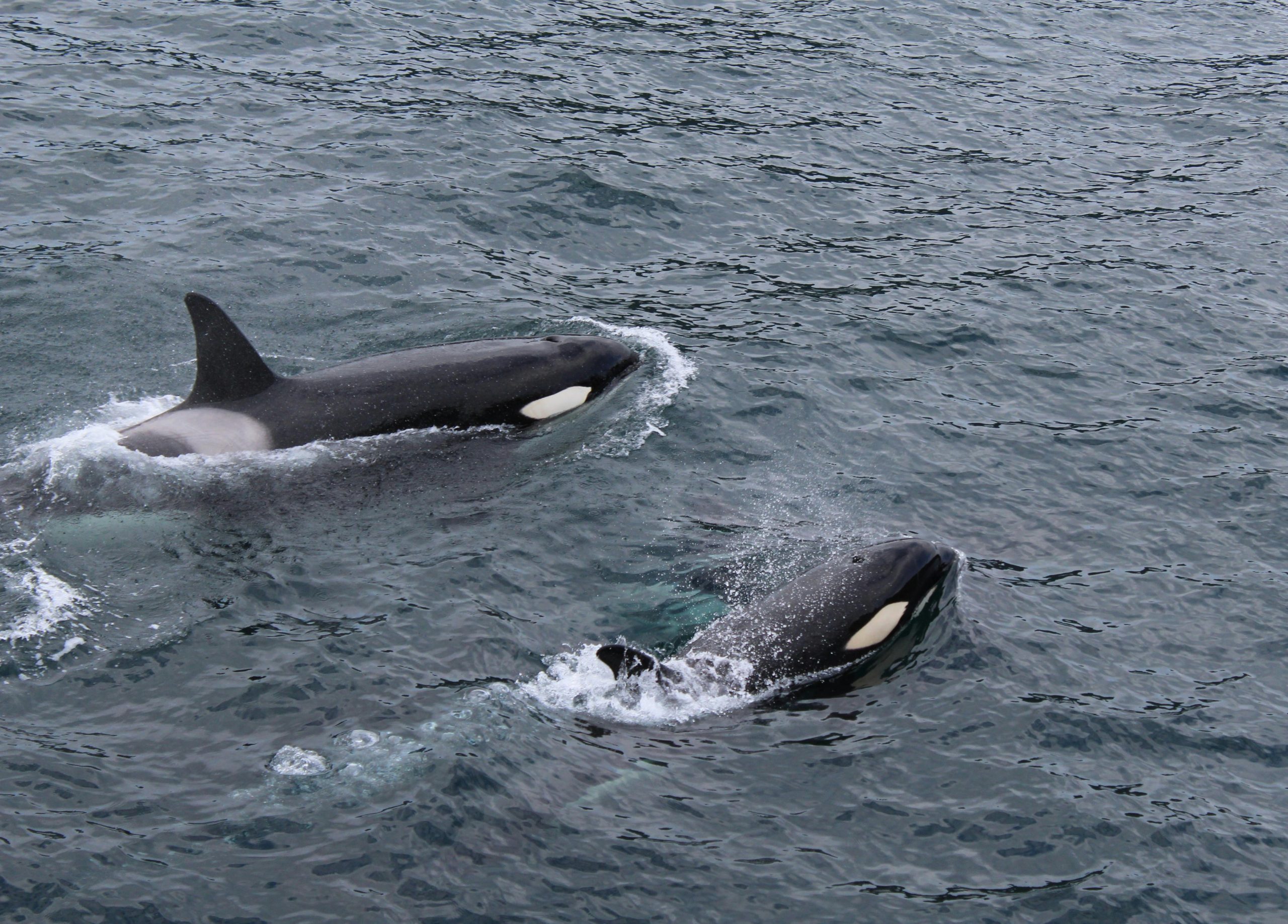
Orcas, or killer whales, are apex predators within the marine world and are found throughout the globe’s oceans. Orcas exhibit remarkable adaptations and behaviours that enable them to thrive in one of the harshest environments on Earth.
As intelligent and social mammals, orcas are not only the largest member of the dolphin family but also among the most powerful predators on the planet.
Antarctic orcas are classified into four distinct ecotypes, Types A through D, each with unique physical traits, prey preferences, and behaviours. This diversity within a single species reflects the incredible biodiversity of Antarctic waters, underscoring the complexity of life in the Southern Ocean and the need to protect its fragile ecosystems.
Appearance
Orcas have a distinctive black-and-white colour pattern, with a strong, robust body and a tall dorsal fin. Adult males can grow up to 9.8 meters (32 feet) and weigh over 6 tonnes, while females are slightly smaller. The four Antarctic ecotypes differ notably in size, colouration, and dorsal fin shapes, each adapted to different habitats and prey:
– Type A: The largest ecotype, with a typical orca pattern and a prominent eye patch, usually found in open ocean waters.
– Type B (Large): Features a larger eye patch and a pronounced cape; often hunts seals near pack ice.
– Type C (Small): The smallest Antarctic ecotype, with a narrow, slanted eye patch and a yellowish tinge from diatom accumulation on the skin, primarily hunts fish.
– Type D: Characterized by a small eye patch and bulbous head, this rarely seen type inhabits subantarctic waters and may specialise in deep-sea fish and squid.
Behaviour
Orcas are highly social animals, living in matrilineal groups called pods, which consist of complex social structures led by a matriarch. Each ecotype exhibits sophisticated hunting techniques and unique vocalizations that are fine-tuned to their prey and environment:
– Type A orcas primarily hunt minke whales in the open ocean.
– Type B orcas work together to hunt seals on pack ice, using coordinated wave-washing tactics.
– Type C orcas hunt fish, especially the Antarctic toothfish, using a collaborative approach beneath the sea ice.
– Type D orcas, though less studied, are believed to hunt large fish and squid in deeper waters.
This behavioural diversity illustrates the adaptability of whales in Antarctica and highlights the ecological complexity within orca populations.
Diet
Each orca ecotype has evolved unique hunting specializations, demonstrating the versatility of whales in Antarctica as predators:
– Type A orcas focus on large cetaceans, particularly minke whales.
– Type B orcas are known for their innovative wave-washing technique, which knocks seals from ice floes.
– Type C orcas coordinate to encircle and capture fish under the ice.
– Type D orcas, due to their elusive nature, are thought to prey on deep-sea fish and squid.
These specialized hunting methods underscore the orca’s adaptability and the critical role they play in regulating prey populations within the Antarctic ecosystem.
Reproductive Cycle
Orcas have a long gestation period of around 17 months, with females typically giving birth to a single calf. The interval between births can range from 3 to 8 years, depending on environmental factors and ecotype. Calves remain closely bonded to their mothers, nursing for at least a year and often staying within the maternal pod for life.
This extended period of dependency allows calves to learn essential social and hunting skills, reinforcing the complex social structure among whales in Antarctica.
Habitat & Range
Antarctic orcas inhabit various parts of the Southern Ocean, with each ecotype favouring distinct areas based on prey availability:
– Type A orcas inhabit open waters throughout the Southern Ocean.
– Type B orcas are commonly found near the Antarctic Peninsula and in pack ice regions.
– Type C orcas prefer inshore waters and pack ice zones.
– Type D orcas typically reside in subantarctic waters, with limited sightings in Antarctic regions.
This range of habitats showcases the adaptability of orcas within Antarctic waters and highlights their niche specialisations across diverse environments.
Ecological Role
The presence of diverse orca ecotypes within Antarctica emphasizes the adaptability and ecological importance of these apex predators. Understanding and protecting each orca population is crucial for maintaining the biodiversity and ecological health of the Southern Ocean.
As top predators, orcas play a significant role in balancing marine ecosystems by controlling prey populations and contributing to nutrient cycling within their habitats.
The conservation of orcas in Antarctica requires coordinated global efforts to protect the unique and vulnerable marine ecosystems of the Southern Ocean. Preserving these remarkable creatures ensures the continued vitality of Antarctic waters, reinforcing the need for international action to safeguard biodiversity and sustain the health of one of Earth’s most critical marine environments.
Further Reading
The Antarctic and Southern Ocean Coalition has some great information about whales.
Back To Top

